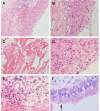A Potential Concomitant Sellar Embryonic Remnant-Associated Collision Tumor: Systematic Review
- PMID: 33996567
- PMCID: PMC8117962
- DOI: 10.3389/fonc.2021.649958
A Potential Concomitant Sellar Embryonic Remnant-Associated Collision Tumor: Systematic Review
Abstract
Background: Diagnosing the well-known concomitant Rathke's cleft cyst (RCC) and differentiating it from other sellar lesions are difficult because RCC is and other sellar lesions are closely related and represent a continuum from simple RCCs to more complex lesions. The purpose of this study is to better understand the adeno- and neurohypophysis adjacent to the par intermedia remnants and their role in the origin of the coexistence of these two distinct tumor neoplasias; to assess the incidence in different age groups; to categorize the pathohistological subtype, which can be incorporated in predictive/prognostic models; and finally, to evaluate the current evidence on collision tumors of the sellar embryonic remnant tract in terms of their biological behavior and pathology.
Methods: Utilizing the PubMed database, data were collected from 1920 to 2019. Information about demographics, clinical characteristics, and age was summarized and analyzed by using univariable and multivariable models. The same cell type was observed regardless of whether the tumor was only one type or mixed types, and their histologic patterns were assessed.
Results: The incidence rates were similar among patients stratified into three age subgroups: 40-49 years (24.57%), 50-59 years (19.54%), and older than 60 years (22.98%). We found that various types of sellar lesions, namely, squamous metaplasia (SM) + goblet cells (GC) (HR 46.326), foamy macrophages (FM) (HR 39.625), epithelial cells and multinucleated giant cells or cholesterin (EM) (HR 13.195), a cavernous portion of the right internal carotid artery (CP-ICA) (HR 9.427), epithelial cells with ciliated cuboidal (EC-CC) (HR 8.456), were independently associated with RCC pathological status. These divergent AUCs (0.848 for Hypo as RCC, 0.981 for RCC co PA, 0.926 for CD and CP co RCC) and subtypes of PA (HR 4.415, HR 2.286), Hypo (HR 3.310), CD and CP (HR 2.467), EC and DC and PG and SGR (HR 1.068), coexisting with the risk of a comorbid RCC lesion, may reflect the etiologic heterogeneity of coderivation and the different effects of some risk factors on tumor subtypes. Our analyses suggested that the greatest accuracy was observed for the pituitary adenoma subtype, with an AUC of 0.981 (95% confidence interval [CI]: 0.959-1.005), while the poorest accuracy was observed for aneurysms, with an AUC of 0.531 (95% CI: 0.104-0.958). We separately analyzed and confirmed the above results. Sensitivity analysis revealed no evidence of systematic bias due to missing data.
Conclusion: This study showed that the histopathological changes in patients with sellar embryonic remnant-associated collision tumors showed highly consistent epithelial cell replacement (renewal) (ciliated columnar epithelium to ciliated squamous epithelium to squamous epithelium) or accumulation, and the RCC cyst wall was similar in structure to the tracheobronchial airway epithelium, with progenitor cell characteristics. The collision accuracy between RCC and other tumors (PAs, craniopharyngioma, chordoma, etc.) is different; these characteristics constitute the theoretical basis for the postmigration development of the pharyngeal bursa.
Keywords: Rathke cleft cyst; collision sellar lesions; cystic sellar lesions; sellar embryonic-remnants lesions; solid sellar lesion.
Copyright © 2021 Wang, Fu, Song, Zhao, Wang, Zhang, Ma and Wang.
Conflict of interest statement
The authors declare that the research was conducted in the absence of any commercial or financial relationships that could be construed as a potential conflict of interest.
Figures






Similar articles
-
Collision sellar lesions: coexistence of pituitary adenoma and Rathke cleft cyst-a single-center experience.Endocrine. 2020 Apr;68(1):174-181. doi: 10.1007/s12020-019-02149-8. Epub 2019 Dec 4. Endocrine. 2020. PMID: 31802354
-
Spontaneous pituitary adenoma occurring after resection of a Rathke's cleft cyst.J Clin Neurosci. 2016 Nov;33:247-251. doi: 10.1016/j.jocn.2016.05.018. Epub 2016 Sep 3. J Clin Neurosci. 2016. PMID: 27600168
-
[Collision sellar lesions: pituitary adenoma and Rathke cleft cyst].Medicina (B Aires). 2021;81(6):1069-1072. Medicina (B Aires). 2021. PMID: 34875610 Spanish.
-
Craniopharyngioma and other cystic epithelial lesions of the sellar region: a review of clinical, imaging, and histopathological relationships.Neurosurg Focus. 2010 Apr;28(4):E4. doi: 10.3171/2010.2.FOCUS09318. Neurosurg Focus. 2010. PMID: 20367361 Review.
-
Collision lesions of the sella: co-existence of craniopharyngioma with gonadotroph adenoma and of Rathke's cleft cyst with corticotroph adenoma.Pituitary. 2008;11(3):317-23. doi: 10.1007/s11102-007-0070-6. Pituitary. 2008. PMID: 17917812 Review.
Cited by
-
Analysis of the Clinical Characteristics and Pituitary Function of Patients in Central China With Rathke's Cleft Cysts.Front Endocrinol (Lausanne). 2022 Feb 28;13:800135. doi: 10.3389/fendo.2022.800135. eCollection 2022. Front Endocrinol (Lausanne). 2022. PMID: 35295993 Free PMC article.
References
-
- Akita S, Readhead C, Stefaneanu L, Fine J, Tampanaru-Sarmesiu A, Kovacs K, et al. . Pituitary-directed Leukemia Inhibitory Factor Transgene Forms Rathke’s Cleft Cysts and Impairs Adult Pituitary Function A Model for Human Pituitary Rathke’s Cysts. J Clin Invest (1997) 99(10):2462–9. 10.1172/JCI119430 - DOI - PMC - PubMed
Publication types
LinkOut - more resources
Full Text Sources
Other Literature Sources
Miscellaneous

